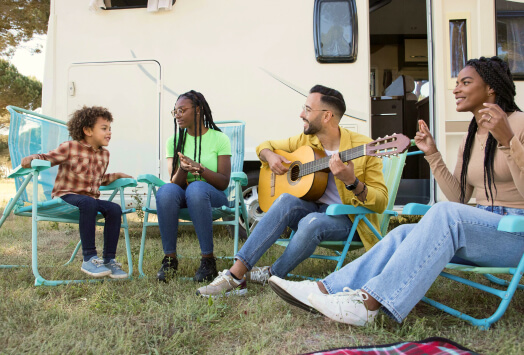As we get ready for the holidays, preparing your family for time off from school can get a bit stressful. You need to find winter break activities and balance your child’s schedule so they have fun but don’t feel too busy. However, if you are planning a vacation, considering how to travel safely with your children and keep them active and happy during the trip can be difficult.
That is why the team at Sawyer wanted to outline the best family travel tips to help you keep your child on their routine, balanced in their activities, and happy on your trip.
Family travel tips
Balancing your child’s routine on vacation
When you go somewhere new, it can throw your child’s routine out of whack. Whether it is from jet lag or just different activities and timing, a ruined routine can lead to tantrums, which is no fun for you or your child. Here are some of our best tips to balance your child’s routine while on vacation so everyone has a good time.
Pack lunch
Healthy food energizes your child and gives them the boost they need to make it through tough travel days and jam-packed activities. Include fruit & veggies as well as protein and carbs for their meals and snacks so that they can avoid energy dips and spikes that come with junk food.
Be intentional with screen time
Make sure you balance your child’s screen time with non-screen activities. Keep an entertainment bag filled with non-screen based activities with your carry-on suitcase. Some examples: LEGO, modeling clay, invisible ink markers, cards, coloring books, and more. You can also use this time for educational activities to fight the learning loss that occurs when children are off from school for extended periods of time.
Plan but don’t over plan
Start by planning one activity per day and then you can determine if your children have the stamina for another that day. This usually depends on their age and the type of activity. For example, if you take a long walk through a city or go snorkeling, then younger children will likely not be able to handle another activity that day. But, if you do something on the lighter side, like go to a children’s museum or take a walk in a park, you can probably add onto the day. If your children are on the older side, let them be part of the planning.
Be mindful of sitting time
Children, teens, and adults need to move their bodies to feel productive and get their energy out. When you are traveling, there is a lot of time spent sitting - in the car, waiting for events, in the plane, or out to eat. Make sure you make time to get out and explore or visit a local playground.
Schedule time for rest
Generally, younger children need more downtime, but all children (and adults!) can use time to rest, be quiet, and even be alone. Try to keep your childrens’ bedtimes as close to their usual routine as possible. As parents, you know how lack of sleep can affect your child during the day, so for the sake of the vacation, a good night’s sleep is helpful in combating tantrums, whining, and overall exhaustion.

Traveling with a toddler
Traveling with a toddler could be an Olympic sport. Here are some of our best tips to make your trip as easy as possible (sorry - no promise that it will actually be easy, though).
- Never go without snacks. It is often easier to get your toddler to graze on snacks during your travels than to sit them down for a whole meal. Plus, when traveling with a toddler you want to keep them happy and delicious snacks are often the key to their heart.
- Choose safety. It might be less expensive to put your under-2 year old toddler on your lap for a flight, but the FAA recommends that you put your child in a carseat on the flight instead. Likewise, if you are going to rent a car at your destination, make sure you rent a car seat, too!
- Vary the entertainment. Screens are helpful at keeping your toddler busy for a bit, but you really need to provide a variety of entertainment options to keep them happy while traveling. Let them help you pack their bag, but make sure you include their all-time favorite books, small toys, and interactive activities. Just try to choose quiet games and activities for the sake of your fellow passengers.
- Learn together. As you prepare for a trip, help your child understand where you are going, what you will see, and why it is important. You can print out activities related to your destination, download podcasts or children’s shows, and discuss with your child. At the end of the trip, you can talk about what you did and learned while you were gone!
- Encourage your child to be independent. When you can, traveling with your toddler can be a great way to teach responsibility to your child. Ask them to carry their own backpack, walk with you in the airport, and tell you when they are hungry or want to do a different activity.

Traveling with an infant
It might feel daunting to plan and take a trip with a baby. But, whether you are going to visit family or just taking a much-needed vacation with your family, traveling with an infant is sometimes necessary. Here are our best tips to help you have a peaceful and safe trip.
- Give yourself extra time. Whether you are going to the airport, on a road trip, or to an activity, you should always leave early and plan to arrive early. Infants often have unexpected poop explosions, tantrums, needed feedings, and more that can require extra time.
- Bring what you need. You might feel like you are overpacking, but it is better to have everything you could possibly need to make your trip as easy as possible. A stroller, car seat, baby bjorn, and pack & play are all important items to pack so you and your infant are comfortable in transit and at your destination.
- Keep your baby’s schedule in mind. If you can, plan your travels around your infant’s nap time or happy time. While on your tip, make sure you keep as close as possible to your child’s schedule. Routines are helpful to avoid overstimulation for your baby so that they are happy and well rested.
- Feed your baby during takeoff and landing. Infants’ ears are especially sensitive to the changes in air pressure that occur during takeoff and landing. That’s why experts recommend that you feed your baby a bottle (or nurse them) during those times to help their ears adjust and keep them from crying. If you don’t want them to eat or if they’re not hungry, try a pacifier.
- Wear your baby when you can. Whether you are going through the airport, taking a small hike, or exploring a new city, wearing your baby gives you free hands and helps you move more confidently on uneven surfaces. If you can find a backpack diaper bag, that’s a great way to continue your hands-free life.
Looking for more tips on how to keep your children happy and having fun while off from school? Check out our blog to learn how to keep your child learning during school break and more resources to help you as you navigate this unstructured time.

















